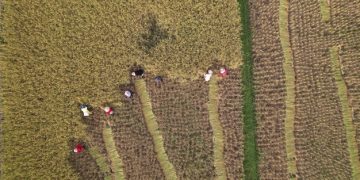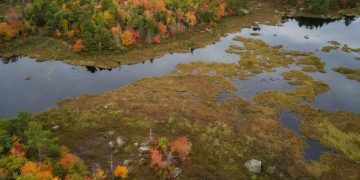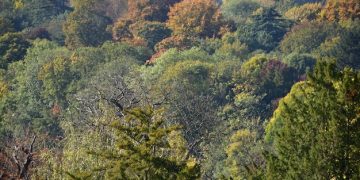How Private Landowners Enhance Wildlife Conservation: Practical Steps
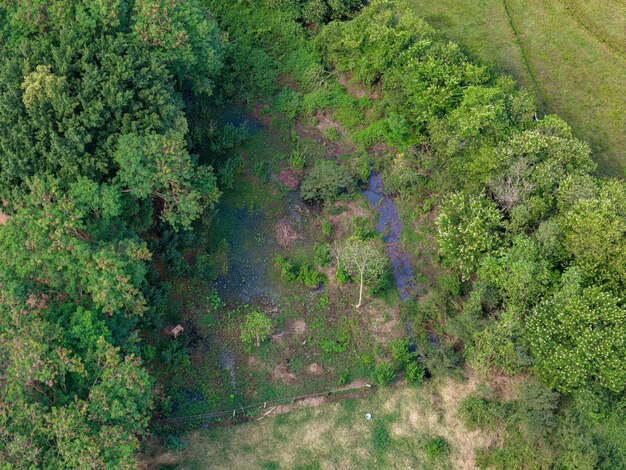
Private landowners play a crucial role in wildlife conservation efforts through habitat management, conservation easements, sustainable practices, and collaboration with conservation organizations.
Discover **how private landowners can contribute to wildlife conservation efforts on their property** by implementing strategies that enhance habitat, promote biodiversity, and ensure the long-term health of ecosystems.
Understanding the Importance of Private Land in Wildlife Conservation
Private lands make up a significant portion of the United States, playing a vital role in supporting wildlife populations. Conservation efforts managed by private landowners can significantly impact biodiversity and ecosystem health.
Effective stewardship of these lands is crucial for maintaining habitats, protecting endangered species, and ensuring the resilience of ecosystems in the face of environmental changes.

The Role of Private Landowners
Private landowners often possess unique knowledge of their land and its ecological features, making them valuable partners in conservation. Their actions can complement public conservation efforts and create interconnected habitats across larger landscapes.
- Habitat Management: Private landowners can actively manage habitats to benefit specific wildlife species.
- Conservation Easements: These legal agreements protect land from development, ensuring long-term habitat preservation.
- Sustainable Practices: Implementing farming and forestry practices that minimize environmental impact is essential.
By understanding the unique ecological value of their property, landowners can make informed decisions that enhance wildlife conservation.
Ultimately, the participation of private landowners is essential for a comprehensive approach to wildlife conservation, enhancing the health and resilience of our ecosystems.
Creating a Wildlife Habitat Management Plan
A strategic habitat management plan is essential for maximizing the positive impact of conservation efforts on private lands. This plan should outline specific goals, objectives, and actions tailored to the ecological characteristics of the property.
It should be based on a thorough assessment of the land’s resources, including soil types, water sources, vegetation, and existing wildlife populations. Understanding these factors is crucial for designing effective conservation strategies.
Assessing Your Land
Begin by conducting a detailed inventory of your property’s natural assets. This involves identifying the different habitat types present, such as forests, grasslands, wetlands, and riparian areas.
Document the plant species and wildlife species that are currently present, as well as any unique or sensitive ecological features that warrant special consideration.
Setting Clear Objectives
Define specific, measurable, achievable, relevant, and time-bound (SMART) objectives for your habitat management plan. These objectives should align with your overall conservation goals and the ecological needs of your property.
- Increase Native Plant Diversity: Restore native vegetation to enhance habitat structure and food sources for wildlife.
- Improve Water Quality: Implement erosion control measures to reduce sedimentation in streams and wetlands.
- Enhance Forest Health: Thin overcrowded forests to promote the growth of mature trees and improve understory vegetation.
Careful planning and assessment of the land helps to set reasonable goals and achieve wildlife conservation.
By setting clear, measurable objectives, landowners can track their progress and make adjustments to their management strategies as needed.
Implementing Best Management Practices for Wildlife
Best Management Practices (BMPs) are essential tools for landowners seeking to enhance wildlife conservation on their property. These practices are designed to minimize negative impacts on ecosystems while promoting sustainable land use.
BMPs can be applied to a wide range of activities, including farming, forestry, grazing, and construction. By implementing BMPs, landowners can protect water quality, reduce soil erosion, and maintain healthy habitats for wildlife.
Farming Practices
Implementing conservation tillage practices, such as no-till farming, can reduce soil erosion and improve water infiltration. Crop rotation can enrich the soil and break pest cycles, minimizing the need for chemical inputs.
- Buffer Strips: Establish vegetated buffer strips along streams and wetlands to filter runoff and provide habitat for wildlife.
- Cover Crops: Plant cover crops during fallow periods to prevent soil erosion and improve soil health.
- Integrated Pest Management: Use biological controls and targeted pesticide applications to minimize environmental impact.
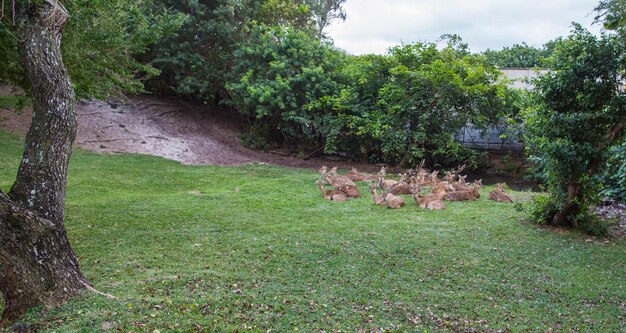
Forestry Practices
Sustainable forestry practices involve carefully planning timber harvests to minimize impacts on wildlife habitats. Selective harvesting can maintain a diverse forest structure, providing a variety of habitats for different species.
Retaining snags (standing dead trees) and large woody debris provides essential habitat for cavity-nesting birds, mammals, and amphibians.
Effectively using farming and forestry practices can have positive impacts on wildlife.
Ultimately, the successful implementation of BMPs requires a commitment to sustainable land management and a willingness to adapt practices based on ongoing monitoring and evaluation.
Establishing Conservation Easements
Conservation easements are legal agreements between landowners and qualified conservation organizations or government agencies that restrict the type and amount of development that can occur on a property. This ensures the long-term protection of valuable natural resources, including wildlife habitats.
By establishing a conservation easement, landowners can receive tax benefits and ensure that their land remains in its natural state for future generations. Conservation easements are flexible and can be tailored to meet the specific needs and goals of the landowner.
Benefits of Conservation Easements
One of the primary benefits of conservation easements is the ability to protect land from development in perpetuity. This provides long-term security for wildlife habitats and ensures that important ecological features are preserved.
In addition to protecting land, conservation easements can provide significant tax benefits to landowners. These benefits may include deductions on federal and state income taxes, as well as reductions in estate taxes.
- Reduced Property Taxes: Reduced property taxes due to the restrictions placed on the land.
- Estate Planning: Conservation easements can simplify estate planning and ensure that the land is transferred according to the landowner’s wishes.
- Financial Incentives: Some conservation organizations offer financial incentives to landowners who establish conservation easements.
The financial and environmental advantages allow landowners to consider them.
Ultimately, conservation easements represent a powerful tool for landowners seeking to protect their property’s natural resources and contribute to long-term wildlife conservation.
Monitoring Wildlife Populations and Habitat Health
Monitoring wildlife populations and habitat health is an essential component of effective conservation management. Regular monitoring provides valuable data on the effectiveness of conservation efforts and allows landowners to make informed decisions about their management strategies.
There are a variety of monitoring techniques that can be used, depending on the size and type of property, as well as the wildlife species of interest. These techniques may include visual surveys, camera trapping, habitat assessments, and water quality testing.
Monitoring Techniques
Visual surveys involve observing wildlife species directly, either from a fixed point or along a predetermined transect. This technique is particularly useful for monitoring bird populations, large mammals, and other easily observable species.
Camera trapping involves setting up remote cameras that are triggered by motion, allowing landowners to capture images of wildlife species that may be difficult to observe directly.
- Habitat Assessments: Evaluate the condition of different habitat types on the property.
- Water Quality Testing: Monitor water quality in streams, wetlands, and ponds to assess the impacts of land management practices.
- Data Analysis: Analyze the data collected through monitoring efforts to identify trends and assess the effectiveness of conservation strategies.
Landowners can better track wildlife and better strategize conservation methods based on the findings.
Ultimately, monitoring wildlife populations and habitat health is an ongoing process that requires commitment and attention to detail. By monitoring conservation processes, one can better conservation and wildlife.
Collaborating with Conservation Organizations and Agencies
Collaborating with conservation organizations and agencies is crucial for landowners seeking to maximize the impact of their conservation efforts. These organizations can provide valuable expertise, technical assistance, and financial support to help landowners implement effective management strategies.
Many conservation organizations offer programs specifically designed to assist private landowners, including habitat restoration projects, cost-share programs, and educational workshops.
Finding the Right Partners
Research local, regional, and national conservation organizations to identify potential partners that align with your conservation goals. Look for organizations that have a proven track record of working with private landowners and a strong understanding of the local ecology.
Contact your local Natural Resources Conservation Service (NRCS) office to learn about federal programs that provide technical and financial assistance to landowners for conservation practices.
- Partnerships: Collaborate with conservation organizations to develop and implement habitat management plans.
- Workshops: Attend workshops and training sessions to learn about best management practices for wildlife conservation.
- Apply: Apply for grants and cost-share programs to fund conservation projects on your property.
Partnering offers a wide range of opportunities and assistance to private landowners.
Ultimately, collaborating with conservation organizations and agencies can significantly enhance the effectiveness of conservation efforts on private lands by providing landowners with the resources and support they need to succeed.
| Key Point | Brief Description |
|---|---|
| 🌱 Habitat Management | Actively manage habitats to benefit specific wildlife and enhance biodiversity. |
| 🤝 Conservation Easements | Protect land from development ensuring long-term habitat preservation. |
| 🚜 Sustainable Practices | Implement farming and forestry practices that minimize environmental impact. |
| 📊 Monitoring Efforts | Regularly monitor wildlife populations and habitat health to assess conservation strategies. |
Frequently Asked Questions
▼
Simple ways include planting native trees and shrubs, reducing mowing frequency, and creating brush piles for shelter. These actions provide food, cover, and nesting sites for various wildlife species.
▼
Effective control involves identifying invasive species and implementing targeted removal methods. This can include manual removal, herbicide application, and prescribed burns, tailored to the specific species and site conditions.
▼
Wetlands provide critical habitat for a variety of wildlife species, including amphibians, waterfowl, and fish. They also help to filter pollutants from water, reduce flooding, and recharge groundwater supplies, promoting ecological health.
▼
Sustainable grazing practices help to maintain plant diversity, prevent overgrazing, and promote healthy soil conditions. Rotational grazing, in particular, allows vegetation to recover and provides varied habitat structures for wildlife.
▼
Various resources can help fund conservation efforts, including federal and state grant programs, cost-share programs offered by conservation organizations, and tax incentives for landowners who implement conservation practices on their property.
Conclusion
Private landowners serve as important stewards of wildlife and ecosystems. Through strategic planning, implementation of best practices, and partnerships with conservation organizations, landowners can effectively enhance wildlife habitats and contribute to overall conservation success.


